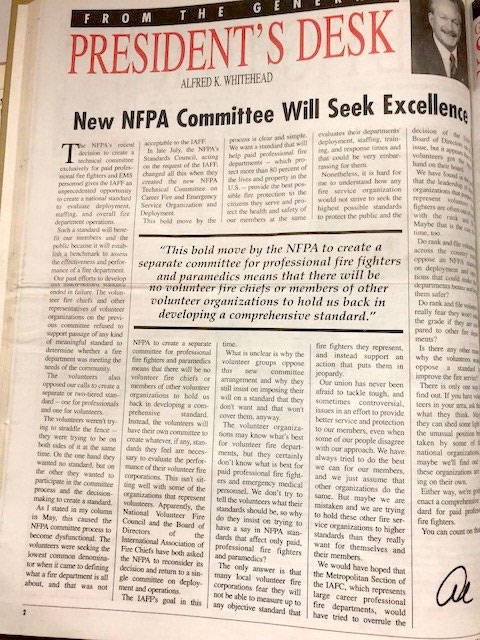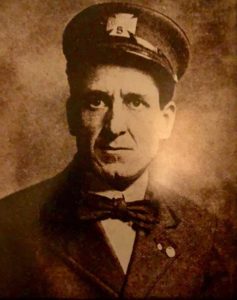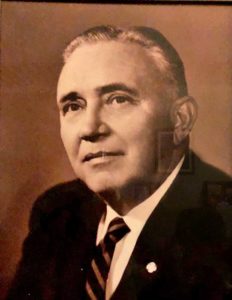The National Fire Protection Association (NFPA) was created in 1896 by a group of insurance firms to standardize fire sprinkler systems. Today, the NFPA advocates scientifically based consensus codes and standards, research and education for fire and related safety issues.
In 1992, a battle over including a minimum fire fighter staffing provision – which recommended that engine or ladder companies assemble at least four members prior to initiating an interior attack on a structural fire – in the NFPA 1500 Standard pitted the IAFF, the U.S. Fire Administration, fire fighters and other fire experts against the International Association of Fire Chiefs (IAFC), the National Volunteer Fire Council (NVFC) and their allies who opposed establishing guidelines on staffing.
IAFF President Al Whitehead charged that the IAFC and the NVFC “have turned their backs on fire fighter safety.” He called their oppositions “one of the most cowardly and outrageous actions in the history of the fire service.”
The IAFF published a special edition of the International Fire Fighter to outline the controversy and defend its position, asking members to write to NFPA regarding the IAFF’s proposed Tentative Interim Amendment, which would add to the NFPA 1500 Standard a requirement for minimum safe fire ground staffing.
In 1993, after NFPA denied the IAFF’s formal request to add safe fire ground staffing language to the NFPA 1500 Standard, the IAFF announced that it was formally ending its 71-year relationship with NFPA, citing NFPA’s utter contempt and disregard for the safety of fire fighters and the public.
The IAFF severed its organizational membership and discontinued its representation on all NFPA committees and sections. This action did not affect any existing laws or policies at the local, state, provincial or federal levels that are based on NFPA Standards.
“IAFF had no choice but to leave NFPA. The NFPA and its allies – not the IAFF – made this into a union versus management issue, instead of a safety issue. Because of their actions and because we tried to operate within their system to no avail, we will now react like the strong union we are.”Al Whitehead, IAFF General President (1988-2000)
“The NFPA has demonstrated an inability to address the fundamental needs of safety for fire fighters,” said IAFF General President Al Whitehead. “In our judgment, it would be hypocritical for the IAFF to continue support amounting to a perception of endorsement of the NFPA’s actions.”
More than a year after severing all ties with NFPA, and after months of discussion between the IAFF and senior officials with NFPA, the IAFF Executive Board voted to rejoin NFPA in April of 1994 after resolving a dispute over NFPA’s refusal to support a minimum safe fire ground standard, among other issues. The IAFF once again was represented on the NFPA Board of Directors and technical committees relevant to the interests of paid, professional fire fighters.
“The discussions that took place between the NFPA and the IAFF over the past months have proved the old adage that honest men can have honest disagreements,” said President Whitehead. “And in this case, they can also reach an honest solution.”
In 1995, the Standards Council of the NFPA reneged on a commitment to the IAFF to create an NFPA Technical Committee solely dealing with occupational standards for professional fire fighters. The NFPA instead established a committee that also included volunteers, as well as part-timers. The plan to form a committee on standards for professional fire fighters came after the IAFF pulled out of the NFPA in early 1993, and it was one of the major reasons the IAFF agreed to rejoin the NFPA.
In 1998, the NFPA’s Standards Council finally voted in favor of the IAFF proposal to create a new NFPA committee to develop separate standards exclusively for career, professional fire departments to evaluate the overall capabilities of their departments, including deployment, staffing, organization and operations.
“This bold move by the NFPA to create a separate committee for professional fire fighters and paramedics means that there will be no volunteer fire chiefs or members of other volunteer organizations to hold us back in developing a comprehensive standard … the IAFF’s goal in this process is clear and simple. We want a standard that will help paid professional fire departments – which protect more than 80 percent of the lives and property in the U.S – provide the best possible fire protections to the citizens they serve and protect the health and safety of our members at the same time.”IAFF General President Al Whitehead (1988-2000)




